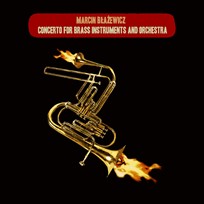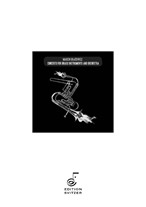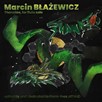
Concerto for Brass Instruments and Orchestra
Composer: Marcin Blazewicz
Instrument: Brass and Orchestra
Level: Advanced
Published: 2009
Price: €60.00
Item details
-
Description +
-
Duration: 25 min.
“Concerto for Brass Instruments and Orchestra” The last century saw a great developments in the technique of playing brass instruments. This concerns not only the extension of the scales and enhancing the technical possibilities of performing various complex passages, but also a completely new quality in regards to the colour and articulation. Most importantly, however, the last century discovered verbal brass wind instruments. Brass wind instruments gradually started to take their proper place among instruments able to express all subtleties and emotions conveyed by the music. Their potential is nowadays really tremendous, unprecedented in the whole history of music.
“Concerto for Brass Instruments and Orchestra” by Marcin Błażewicz is a composition which takes full advantage of all those achievements. In his music, brass instruments become a carrier of a full palette of musical expressions: from brutal, fierce and energetic passages in Part I and III, to subtle, delicate and colourful motifs in Part II.
What is more, the orchestra is given the opportunity to demonstrate all technical skills: brilliant transitions, jumps, double and triple blasts etc.
The piece consists of three parts.
Part I Allegro assai /I = 138/ is a powerful sonata-allegro, whose main theme appears shortly after a brief, quivering introduction performed by stringed instruments. The cadence at the end of this part gives the soloists a great opportunity to present their technical skills.
Part II is a loose fantasia. After a short introduction by the orchestra, in the part performed by brass wind instruments there is a canon that requires a particularly acute sensitivity to the colour. The technique of imitation is the factor that determines the form in this part. Concurrently, the changes of the form are shaped with the use of dynamic and textural contrasts. The orchestra may present its sensitivity to colours and emotions.
Part III is a quasi rondo with a strong energetic charge. This part is based on a characteristic triolic rhythm, whose internal dynamics and the requirement of proper articulation gives the music an exceptional, underlying strength. At the end of the second part there is another cadenza. The concert is characterised by brilliant instrumentation. The relation between the orchestra and the soloists resembles concerts composed in the classical manner, where soloists may not only exhibit their technical skills, but also serve as the medium for the most profound musical expression.
-
-
Instrumentation +
-
ORCHESTRA
3 flauti / 1., 2. muta in flauto picc. (Fl., Fl.picc.)
3 oboi (Ob.)
3 clarinetti / 1. muta in clarinetto picc. (Cl., Cl.picc.)
2 fagotti (Fg.)
contrafagotto (Cfg.)
4 corni (Cr.)
Solisti:
4 trombe / 1., 2. muta in tromba picc. (Tr., Tr.picc.)
1 corno (Cr.)
4 tromboni / 4. trombone basso ossia contrabasso (Tn.)
1 tuba (Tb.)
timpani (Tmp.)
batteria (4 esecutori):
I - xilofono (Xf.), 3 piatti sospesi (Ptt.)
II - 3 tamburi militare (Tmb.), 3 piatti sospesi (Ptt.), 3 bonghi (Bgs.), conga (Cg.)
III - tamburo, 5 tom-toms (Tomt.), gran cassa profonda (Gr.c.), 3 piatti sospesi (II batt.)
IV - gran cassa, 3 piatti sospeso, 2 tam-tam (grande, profondo) (Tmt.)
violini I (Vni I)
violini II (Vni II)
viole (Vle)
violoncelli (Vc.)
contrabassi (Cb.)
-
-
About the composer +
-
Composer and teacher. Born in Warsaw in 1953. He began to study music when he was 13 years old, first at the Oskar Kolberg primary Music School then at the F. Chopin Secondary Music School (double bass). Upon passing his secondary school leaving examination (matura) he studied natural philosophy at the Academy of Catholic Theology for one year (1975/76). Upon graduating from secondary music school in 1977 he began to study at the Department of Composition, Conducting and Theory of Music at the Fryderyk Chopin Academy of Music in Warsaw in Professor Marian Borkowski's class of composition which he finished with honours (1977-1982). He attended composer courses led by François Bernard Mâche (Pécs, Hungary 1980) and Yannis Xenakis (Salzburg, Delft 1985), obtained a SACEM scholarship from Sociéte des Compositeurs et Editeurs de Musique (France) and, as holder of an Acanthes scholarship, he attended a course in composition led by Olivier Messiaen in Avignon (France) in 1987.
Professor Marcin Błażewicz has been a member of the faculty of the AMFC in Warsaw since 1985, first as assistant then tutor (1996-2003) and finally as associate professor at the Chair of Composition. He teaches the following subjects: score reading and introduction to composition and instrumentation (his main interest). He has supervised many master's theses. He was deputy dean of FCUM Department I in 1999-2002 and 2005-2008. In 2008 he was elected dean of the Department of Composition, Conducting and Theory of Music for term 2008-2012.
Marcin Błażewicz presented a paper "On the situation in Polish Music after 1989" at the 5th Biennial "La recherche musicale en Europa" (Gif-sur-Yvette, France 1992). He has organised more than 200 concerts propagating contemporary music including several cycles: Presentation of Young Composers, Encounters with Contemporary Music, Young Musicians for Young Audiences (Warsaw 1979-81). Artistic director and founder of the International New Music Forum festival (Warsaw 1983-87), artistic director of the International Festival "Jeunesses Musicales" (Częstochowa, 1986, Warsaw 1990). Co-founder of the Modus group (1983), music advisor to the French Institute in Warsaw (1985-86). Member of the jury of the International Radio Festival Prix Italia (Peruggia 1989). Musical director of the Polish Radio Theatre (1986-97). Editor-in-chief of the journal "Muzyka21" (2000-2001). Since 2005 he has been holding a class of composition in Fryderyk Chopin University of Music/ FCUM/.
-
-
Reviews +
-
To come.
-
-
Credits +
-
Front Cover artist: Marta Paulat Front
Cover graphics and layout: Ronni Kot Wenzell
Engraving: Jerzy Wolosiuk
Printed in Copenhagen, Denmark
Copyright © Edition Svitzer
www.editionsvitzer.com
-


